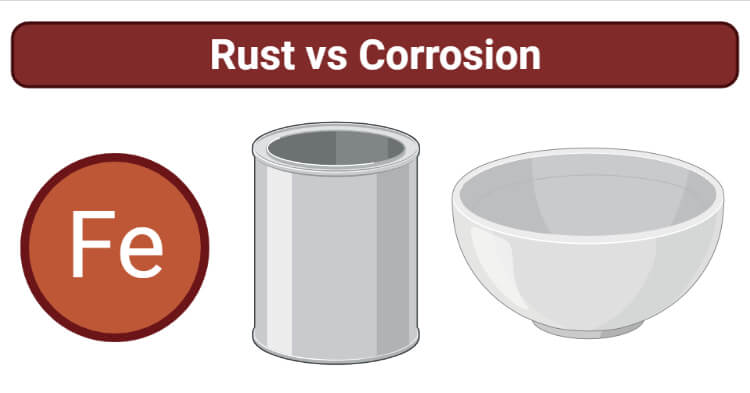Rust Definition
Rust is iron oxide, a reddish-brown oxide formed as a result of a reaction between iron and oxygen in the presence of water or moisture.
- The chemical composition of rust is composed of Fe2O3.nH2O and (FeO(OH).Fe(OH)3. Rust is often associated with corrosion of iron, even though both of them are quite different in their process.
- Rusting is a chemical process that can occur in all masses of iron, where the presence of water and oxygen can cause even large masses of iron to rust.
- The term rusting is often used exclusively for the corrosion of iron and its alloys like steel.
- Rust can either occur on the surface of the metal or within the metal. The surface rust is usually flaky and friable that provides no protection to the underlying iron.
- There are different structures of rusts that are distinguishable by techniques like spectroscopy or visual observation.
- Rusting is often taken as a negative mechanism, but some form of rusting can increase the stability of the metal by forming a thin coating over the iron below. This form of rust is called stable rust.
- Rust is an oxidation process caused by oxygen and other oxidizing agents; however, it is not the only process. The oxidation products combine with other molecules to form rust.
- The primary catalyst for the process of rusting is water. Tiny water molecules can penetrate through the microscopic pits on the iron or steel structures.
- Besides being an oxidation process, rusting is also an electrochemical process resulting from the transfer of electrons from iron to oxygen.
- Intense rust on iron and steel products is a problem as such metals products are used for different purposes.
- Rust prevention can be achieved by the addition of coatings on the surface. These coatings usually protect the layer lying underneath from coming in contact with air and moisture.

Corrosion Definition
Corrosion is the process of conversion of metal into a more chemically stable form like oxides, hydroxides, and sulfides.
- It is a natural process that involves the gradual destruction of materials (which is usually metal) by chemical as well as electrochemical means.
- Corrosion is often used synonymously with rusting; however, rusting is almost exclusively used in the case of iron and its alloys whereas, corrosion can occur in different types of metals.
- Corrosion can also be called electrochemical oxidation, as the reaction occurs in the presence of an oxidant and involves the transfer of electrons from one chemical species to another.
- Corrosion can also occur in materials other than metals like ceramics and polymers, which is often described as degradation.
- Corrosion is a destructive process that deteriorates the useful properties of materials like strength, appearance, and permeability.
- Corrosion doesn’t necessarily occur due to exposure to moisture or air and might require stronger factors. It is, however, a diffusion-driven process that occurs primarily on exposed surfaces.
- The overall chemical process of corrosion is quite complicated. The process begins at a spot where oxidation causes the spot to behave as an anode.
- The electrons from the spot then move through the surface and reach a new spot. The electrons then take up the oxygen present in the area to form water molecules. This new spot behaves as a cathode.
- Corrosion, like rust, can result in the loss of different properties of the compound, and thus, it is useful to apply procedures to prevent it.
- The corrosion resistance of different substances can be increased by processes like surface treatments and cathodic or anodic protection.
6 Key Differences (Rust vs Corrosion)
| Characteristics | Rust | Corrosion |
| Definition | Rust is iron oxide, a reddish-brown oxide formed as a result of the reaction between iron and oxygen in the presence of water or moisture. | Corrosion is the process of conversion of metal into a more chemically stable form like oxides, hydroxides, and sulfides. |
| Surfaces | Rust primarily occurs on the surface made up of iron and its alloys. | Corrosion can occur on different surfaces like skin, metals, wood, etc. |
| Caused by | Rust is caused by exposure to air or moisture. | Corrosion is caused as a result of exposure to air, moisture as well as other chemicals like acids and bases. |
| Observed as | Rust is observed in the form of a red or orange coating on the surface of the substance. | Corrosion can be observed on different surfaces in different forms. |
| Chemistry | Rust is composed of iron oxides together with other similar compounds. | Corrosion can be composed of salts of different elements. |
| Biological role | No biological process is involved in rusting. | Microbial corrosion can occur in the presence of some specific microorganisms. |
References
- Gautum SD, Pant M and Adhikari NR (2016). Comprehensive Chemistry, Part 2. Sixth Edition. Heritage Publishers and Distributors Pvt. Ltd.
- https://pediaa.com/difference-between-corrosion-and-rusting/
